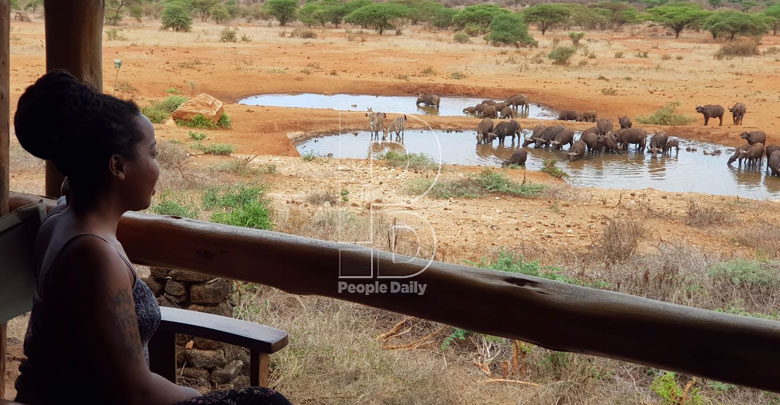Welcome to Serena Kilanguni: Tsavo tuskers, hills and sunsets

“We have to reach the park before 6pm,” Joseph Murigo, our guide and driver, warns while we are stuck somewhere at the Nairobi-Mombasa highway.
It was already 3pm, and we were all crossing our fingers that we would arrive at the Tsavo West National park on time as most parks close at 6pm.
Our destination was Serena Kilanguni, one of the first lodges to be built inside Tsavo, and it’s around 300km from Nairobi, a five-hour drive. Our mission as briefed by Boniface Mathitu, the Safaricom Marathon coordinator, was to pay a visit to Tsavo Trust, one of the conservation projects that has benefited from the Safaricom Marathon.
We arrived at six sharp and drove for another 45 minutes to the lodge, which is inside the park. We were received with a cold refreshing drink, which helped cool down the accumulated fatigue from the journey.
But wait till we got inside the reception, which straight ahead leads to the restaurant. Any remaining bit of exhaustion was washed away by the breathtaking view of the waterhole with animals on the backdrop of the savannah sunset.
I had to quickly adjust my camera and snap some selfies. We all camped there and forgot we had to check in our rooms and at least freshen up. We should have also known that our rooms too had more views. My roommate and I spent the whole time taking photos of the spectacular scene outside our balcony.
The lodge has ensuite rooms with verandas and reliable Internet, something I appreciated, being that I had a lot of work assignments.
At the restaurant, during meal times, one could spot a variety of animals such as elephants, hyenas and buffaloes, all together partaking the precious commodity. I was so mesmerized, but sleep and the fact that we had an early morning couldn’t allow me to spend much time there.
“Cheetahs were here the other night at 10. There’s a waterhole call in case an animal you would like to see comes to quench its thirst,” one of the staff, Milka Mueni, told us as we were about to leave.
Being that I’m not a morning person, add on the fatigue, I declined the request and headed straight to bed. I have this bad habit of not responding to alarms or even wake-up calls from my sisters whenever I plead with them to wake me up early to finish an assignment or just to read.
The view of Mount Kilimanjaro was so clear in the morning as we took our breakfast. This classic stone-built lodge is superbly located on the leeward side of the mountain, and it’s sheltered by the volcanic splendour of the Chyulu Hills.
The view of Mount Kilimanjaro in Tanzania is not as magnificent as it is in Kenya, that’s why plenty of tourists come all the way to just have a glimpse of it on this side of the world. Chyulu Hills, on the other hand, are hills comprising several small flows and cones.
It’s popularly referred to as the land of lions and lava, as its volcanoes are deemed to be active since the last two eruptions occurred in 1856 at Shaitani and Chainu.
In addition, the hills do not have permanent rivers, yet the rainfalls from there feed the Galana, Tsavo as well as Mzima Springs, a place we visited later on in the trip.
We arrived at Tsavo Trust headquarters and found Richard Moller, the CEO, waiting for us, and he welcomed us with a warm smile. The project, which began in 2012, is located inside Tsavo East National Park, and through it, populations of elephants in Tsavo, particularly the large tuskers, are monitored and safeguarded.
Tuskers are a rare species of elephants and there are approximately 30 left on the planet. In Kenya, we have nine in Tsavo, three in Amboseli, one in Northern Kenya and two in Meru National Park.
Historically, Tsavo, which means slaughter in the Kamba dialect, was renowned as the region where elephants were hunted for their magnificently large tusks. It is said that one tusk would weigh around 100 pounds or 45kg.
Since elephant poaching was banned in the 1970s, human-animal conflict, as well as drought, remain the main challenges affecting elephants. The lack of community involvement in the past in conservation matters resulted in a disgruntled populace with a negative perception in as far as the subject is concerned.
The Trust comes with a different approach, of running various projects to sensitize the community on wildlife and the significance of conservation.
“When we came in 2012, we identified 14 seriously big elephants. Only nine remain now. When people think of rare, they only think of rhinos, but not the big tuskers,” says Richard Moller.
We had a chance to also visit a dispensary at Kamungi, which benefits from the funds. The health facility receives 600 patients a day and Margaret Gachifu, a nurse and the person in charge of everything show us the running tap water plus electricity and the expanded rooms that the funds have facilitated. In addition, a fence has been constructed to keep the patients safe from wild animals.
The major challenge they have is the human-animal conflicts and the fact that the majority of women are still delivering at home because of this issue, and also because they lack a proper maternity ward. All that left me grateful of the things we take for granted in life and on my way back to the lodge, I couldn’t help but wonder how in my own little way, I can impact the world.









